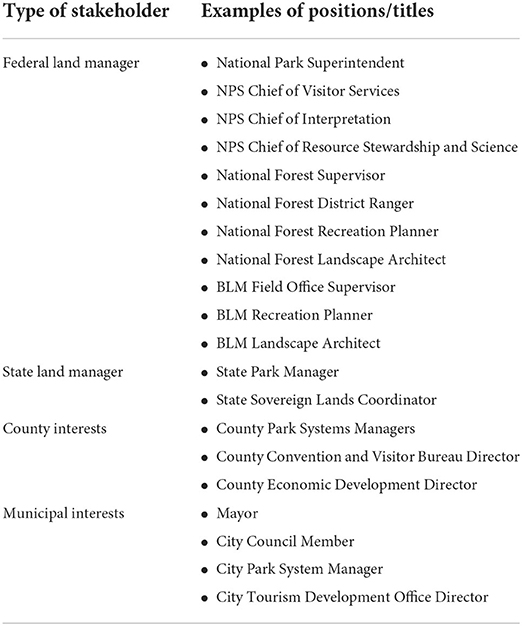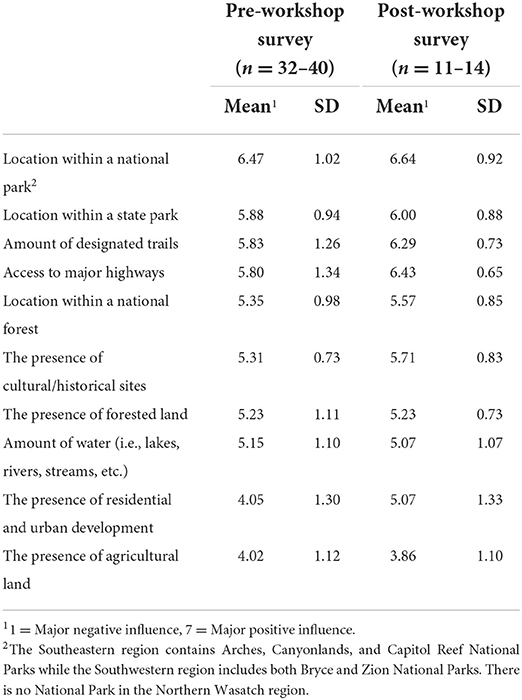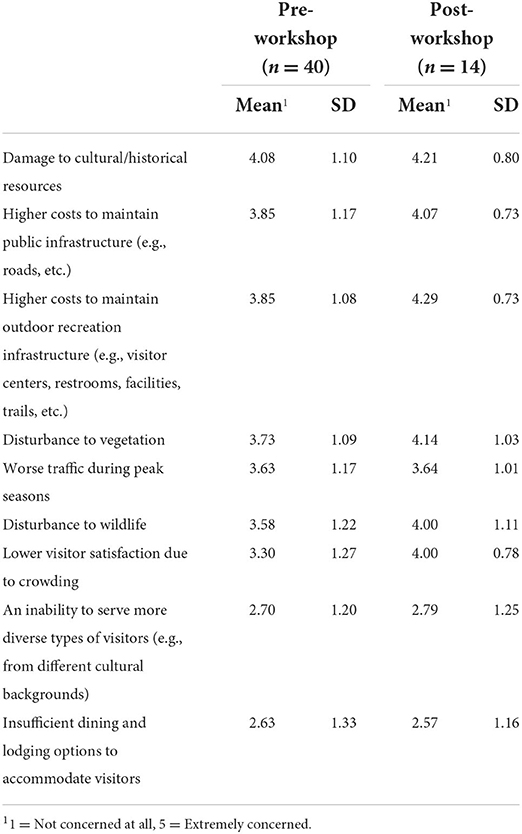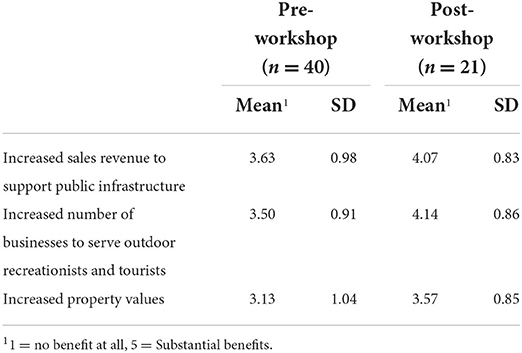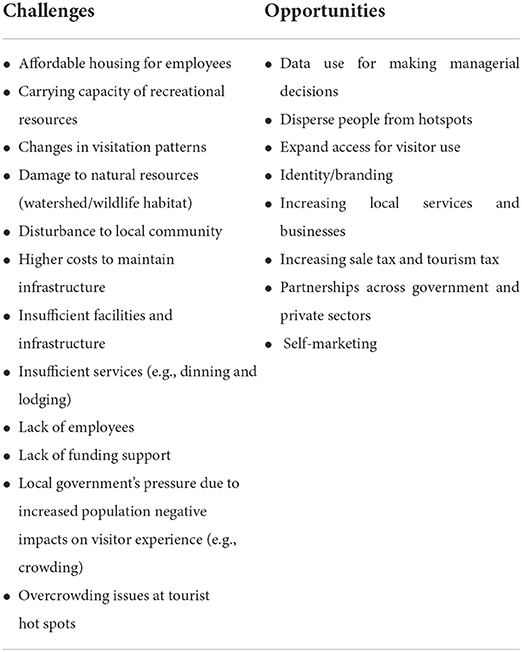- 1College of Tourism, Hunan Normal University, Changsha, China
- 2Department of Environment and Society, Institute of Outdoor Recreation and Tourism, Utah State University, Logan, UT, United States
The collaborative development of scientific and practical knowledge is fostered through processes which allow scientists and stakeholders to work together toward common interests and goals. The purpose of this community case study is to document a process by which big data characterizing the volume and spatial distribution of outdoor recreation and tourism behavior can be used to initiate collaborative discussions amongst the diverse stakeholders involved in outdoor recreation and tourism management. The process we document involves engaging a diverse group of stakeholders including public land managers, county and city government officials, and local business owners, in participatory workshops centered around visualizations of geotagged social media. We document how three workshops with outdoor recreation and tourism providers in Utah (USA) aided in the development of a shared understanding of the challenges and opportunities associated with meeting the growing demand for outdoor recreation and tourism opportunities.
Introduction
Processes that enable inter-organizational dialogue can aid in the development of a shared understanding of the opportunities and challenges faced by local business owners, city and county governments, and public land managers in their efforts to meet the growing demand for outdoor recreation and tourism opportunities. However, the disparate organizations involved in these processes use their own unique methods to monitor trends in outdoor recreation and tourism behavior (Smith and Miller, 2020). These organizations also have discrete jurisdictional boundaries which they are responsible for and have varying mandates and priorities that guide their actions. Visitor use monitoring efforts that span administrative boundaries may provide a common focal point to initiate discussions of the shared opportunities and challenges faced by the numerous agencies and organizations involved in providing outdoor recreation and tourism opportunities.
The purpose of this community case study is to document a process by which big data characterizing the volume and spatial distribution of outdoor recreation and tourism behavior can be used to initiate collaborative discussions amongst the diverse stakeholders involved in outdoor recreation and tourism management. We demonstrate a process by which geotagged social media characterizing outdoor recreation and tourism behavior can be used to initiate dialog amongst diverse stakeholders involved in outdoor recreation and tourism management. Our process is built around concepts from the co-production of knowledge and science communication literatures. The process is exploratory and can be expanded upon in different geographic contexts; it can also be refined through more theoretically driven analyses.
Literature review
The information deficit model in science communication
Scientific findings are most commonly shared with the public following a one-way mode of communication. This approach, referred to as the information deficit model, is described as a linear or one-way communication method in which scientific information comes from scientists to the public without the opportunity for interaction and engagement (Simis et al., 2016; Figure 1). The simplistic nature of the information deficit model has been criticized by many science communication scholars because it does not account for the heterogeneous nature of recipients' learning styles. Culture, sociodemographic characteristics, and individual experiences and worldviews all shape how people engage with, and retain, scientific information (Simis et al., 2016; Suldovsky, 2017). Suldovsky (2017) also suggests the information deficit model is limited in its utility because complex and nuanced science must be boiled down to oversimplified messages or summaries that fail to align with the audience's existing attitudes, behaviors, and knowledge.
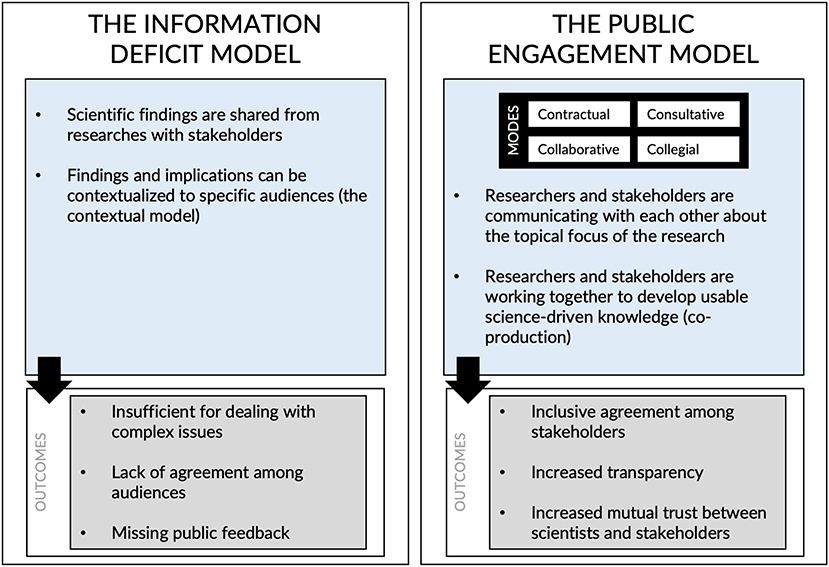
Figure 1. A conceptual diagram showing the difference between the information deficit model and the public engagement model.
Seeking better ways to communicate scientific information, scientists have begun to share scientific findings using experience-dependent, local, and personal evidence (Howe and Leiserowitz, 2013; Kim, 2017). This approach, commonly referred to as the contextual model (a mode of the one-way communication), utilizes audience segmentation as a tool to convey scientific information in the most relatable and understandable way. While the contextual model's use of localized, personally relevant, and evidentiary information, is an improvement over the information deficit model, it has been criticized for merely providing scientific information in a more “eye-catching” manner (Suldovsky, 2017). This model of communication may be insufficient to deal with scientific information in a way that allows audiences to engage with the scientific process or scientific findings in a meaningful way. In other words, the contextual model has been criticized for improving upon the information deficit model while still not providing the opportunity to interact or engage with scientific knowledge directly.
The public engagement model in science communication
The public engagement model addresses some of the limitations of the information deficit and contextual models (Figure 1). Introduced by Biggs (1989), the public engagement model is characterized by two-way communication processes focused on developing co-produced knowledge (Corner and Randall, 2011; Meadow et al., 2015; Popovici et al., 2020). The public engagement model emphasizes the need for, and value of, substantively engaging the public in meaningful dialog. There is no prescriptive method (e.g., town hall style question and answer sessions, virtual forums and public webinars, etc.) through which this dialog can happen. However, advocates for the public engagement model suggest the co-production of knowledge is facilitated by communication that is structured (e.g., professionally facilitated) and transparent (e.g., notes and/or transcriptions of the engagement are made publicly available) (Djenontin and Meadow, 2018). In addition, the co-production of knowledge can be fostered when a diversity of interests are involved in the communication (García and Brown, 2009; Meadow et al., 2015; Wall et al., 2017; Popovici et al., 2020). In the context of outdoor recreation and tourism management, this can involve user groups (i.e., outdoor recreationists and tourists), local and regional elected officials, municipal, state, and federal outdoor recreation planners and tourism development specialists, and relevant non-profit groups.
The co-production process is the unique and arguably essential component of science communication efforts using a public engagement model (Pohl et al., 2010; Beier et al., 2017; Vincent et al., 2018; Popovici et al., 2020). The need for, and value of, co-production processes in sharing scientific findings stems from the failures of communication efforts utilizing top-down communication efforts (Bovaird, 2007; Beier et al., 2017). The participatory and collaborative nature of the co-production process involves acknowledging, responding to, and integrating the attitudes, beliefs, and values of multiple stakeholders into the scientific process so that management decisions, findings, and recommendations, are more likely to be accepted, understood, and acted upon (Figure 1) (Meadow et al., 2015; Vincent et al., 2018; Popovici et al., 2020).
Big data analytics and science communication
Big data are defined by their volume, their ability to address questions at multiple scales (both spatial and otherwise), and their ability to be flexibly integrated with other data (Li et al., 2018). These characteristics have allowed social scientists to investigate social phenomenon in ways that are not possible with traditional research (Kitchin, 2014). As a consequence, big data have the potential to shift social science away from theory-driven methods and toward data-driven investigations (Frické, 2015). However, there is an ongoing debate as to whether there is more value in knowing “what” is happening (more easily elucidated by a data-driven approach) or “why” things are happening (more easily elucidated by a theory-driven approach) (Ekbia et al., 2015). The rising interest in using big data has led to discussion on how big data can be used to improve science communication methods (Lember, 2017; Wiesenberg et al., 2017; Choi, 2020). For example, Wiesenberg et al. (2017) found the use of big data alone can make stakeholders more interested and willing to engage with the science using those data. Importantly, major downsides of using big data in communication and media research have also been noted (Wiesenberg et al., 2017). For example, data mining and big data analytics can be costly, and require analytical and technical skills to distill information down to useful summaries or visualizations. Additionally, limitations on data availability and anonymity pose additional challenges to the use of big data in science communication.
While there is a burgeoning body of work focused on the interface of big data and science communication, there is a limited understanding of how big data can be integrated into public engagement processes (Lember, 2017). How can big data be used effectively in public engagement processes? Can big data be used to catalyze collaborative discussions and the co-production of knowledge? In this investigation, we address these questions within the field of outdoor recreation and tourism management by documenting a process by which big data characterizing the volume and spatial distribution of outdoor recreation and tourism behavior can be used to initiate collaborative discussions amongst diverse stakeholders.
Methods
Our process involved developing a shared understanding of the challenges and opportunities associated with increased participation in outdoor recreation and tourism in Utah, USA. The process included a participatory workshop as well as a pre- and post-workshop survey in three regions of the state1. These regions included a five-county region in the southeastern corner of the state (Southeastern Utah), an eleven-county region in the southwestern portion of the state (Southwestern Utah), and a six-county region along the northern Wasatch Front (Northern Wasatch) (Figure 2).
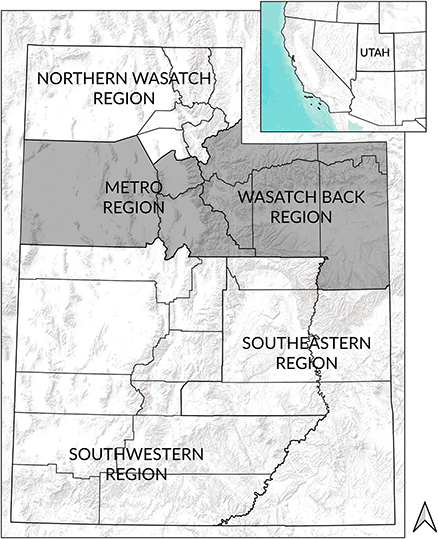
Figure 2. Regions of Utah used to organize the participatory three participatory workshops (held in the Southwestern, Southeastern, and Northern Wasatch Regions).
Workshop participants consisted of federal and state agency staff, county and municipal officials and planning staff, as well as local business owners in the outdoor recreation and tourism industry. Table 1 provides generic titles that were used to help guide stakeholder selection. All invited participants lived or worked in the regions where their workshop took place. All potential participants were emailed an invitation to participate in the workshop2. Initial invitations were followed by two subsequent invitations sent 1-week apart if an invitee had not responded. In total, 372 individuals were invited to participate in the regional workshops and 40 agreed to participate (Table 2)3.
Pre- and post-workshop survey
We used pre- and post-workshop surveys to solicit input on the opportunities and challenges associated with increased outdoor recreation and tourism throughout each region. The surveys were also intended to help prepare potential participants for the discussions that were the focus of the workshops (via the pre-workshop survey) and provide an opportunity for workshop participants to personally re-evaluate their perceptions after the workshop was over (via the post-workshop survey). The surveys were administered via email 1-week before, and 1-day after the in-person workshop took places. Participants were asked to identify their affiliation and the specific counties in which their agency, business, or organization manages land or provides services related to outdoor recreation and tourism.
Participants were also asked to identify what they believed were the five most visited outdoor recreation and tourism destinations within the region; responses were open ended. This question was asked to help familiarize participants with the scope and purpose of the workshops.
Participants were asked about what they believed were the main drivers (e.g., access to major highways, number of designated trails, amount of water, the presence of cultural/historical sites, location within a national park, etc.) influencing outdoor recreation and tourism participation throughout the region. Perceived level of influence was gauged through a 7-point Likert-type scale ranging from major negative influence to major positive influence.
Next, participants were asked to indicate their level of concern for a variety of possible consequences (e.g., lower visitor satisfaction due to crowding, worse traffic during peak seasons, disturbance to wildlife and vegetation, etc.) associated with increased outdoor recreation and tourism throughout their region. Level of concern was measured on a 5-point Likert-type scale that ranged from not concerned at all to extremely concerned.
Finally, participants were asked about how, and to what extent, they believed increased outdoor recreation and tourism throughout their region benefitted the region. Possible benefits asked about included increased sales revenue to support public infrastructure, increased property values, etc. Level of perceived benefit was assessed using a 5-point Likert-type scale ranging from no benefit at all to substantial benefits.
Participants were also given the ability to describe specific opportunities and challenges associated with increased outdoor recreation and tourism throughout the region via an open-ended dialog box.
Participatory workshops
Spatial patterns of outdoor recreation and tourism were measured using social media and validated through comparisons to reported visitation levels where those data are available. Social media were collected between the years 2006 and 2014 through the APIs of both the Flickr and Panoramio platforms4. The spatial mapping and validation process are detailed in Zhang et al. (2021) and publicly available on the openICPSR repository (https://doi.org/10.3886/E131163V1). The mapping process generated statewide, regional, and county-specific maps of outdoor recreation and tourism participation on public lands. We also distilled the statewide and regional maps into “top 10” lists of the most visited tourism destinations. Examples of each type of map and the lists are shown in Figure 3. These maps were presented to workshop participants via large (0.9 x 1.2 m) foam core poster boards set up on easels around a large meeting room.
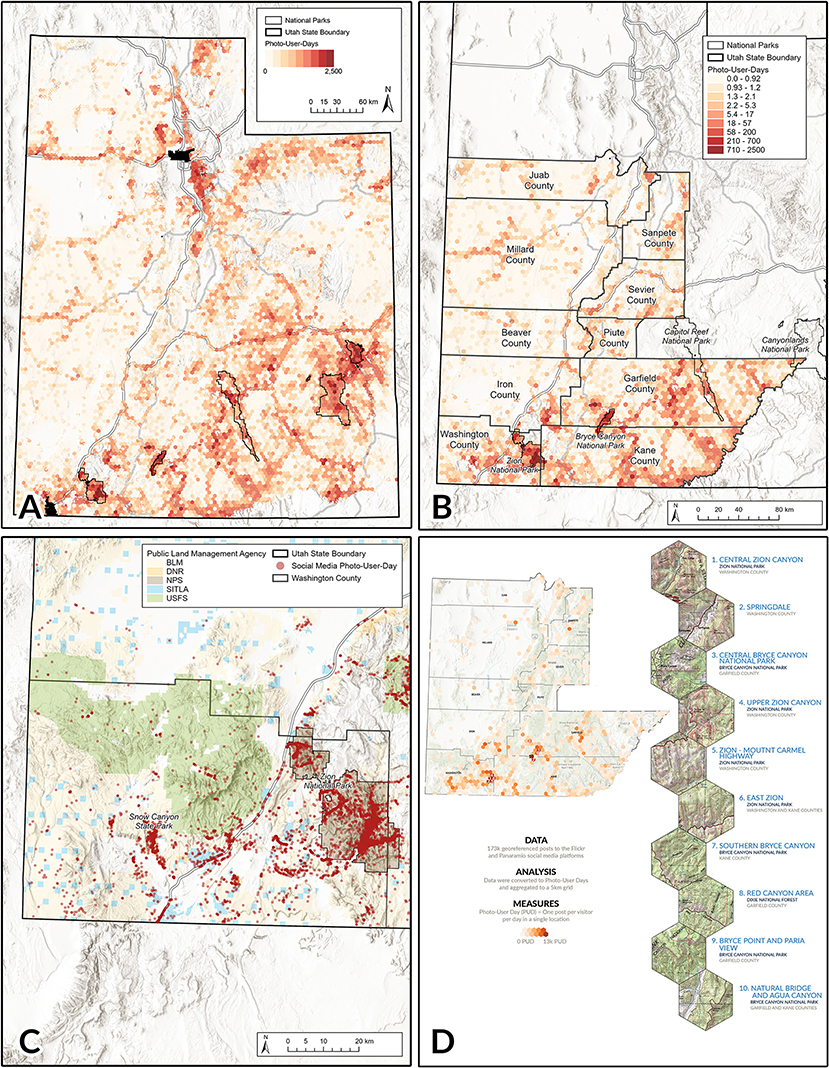
Figure 3. Examples of statewide (A), regional (B), and county (C) maps of geotagged social media along with an example of a rank-ordered “top 10” list (D).
During the workshops, we first gave a short (10–15 min) presentation about how social media is being used in outdoor recreation and tourism management, planning, and research (this presentation was based on Section 2 of Zhang et al., 2021). The process of acquiring and analyzing data were briefly mentioned as well.
Following this short presentation, participants were given the opportunity to walk around the boards and discuss the spatial patterns of visitation informally amongst themselves. After viewing the maps, we led participants through an interactive and collaborative discussion that solicited participants' observations of the spatial patterns of outdoor recreation and tourism on public lands. Following this initial period where they could express their initial reactions, workshop participants were teamed up into groups of four to five to discuss, and come to agreement on, the opportunities and challenges associated with increased outdoor recreation and tourism within their region. The groups of four to five were purposefully constructed to ensure each group had representation from a federal land manager, a state land manager, and a municipal interest. Groups were given ample time to discuss potential opportunities and challenges amongst themselves and also to ask any clarifying questions of the research team. Each group was given a large (0.9 x 1.2 m) poster board to list the challenges and opportunities associated with meeting the growing demand for outdoor recreation and tourism opportunities. After each group had reached consensus, they were invited to share with the larger group while the research team recorded common challenges and opportunities identified across the groups. These common challenges and opportunities were used to generate open discussions of how the region could: (1) mitigate the negative consequences associated with increased visitation; and (2) capitalize on identified opportunities. The workshops concluded by thanking participants and providing them with information about where they could access the maps and study findings on the internet (a project-specific website hosted all maps and made them publicly available). The regional workshops lasted between 2 and 2½ h. The full workshop script is included in the Supplementary material.
Data analysis
All survey responses were collected via the Qualtrics survey application and uploaded into SPSS v.27 for data cleaning and analysis. Data cleaning included checking for participants who either stopped providing responses at a certain question or answered every item with the same response option. Descriptive statistics were used to analyze most of the pre- and post-workshop survey data. The common challenges and opportunities identified during the workshops were transcribed and later archived and shared with workshop participants.
Results
Pre-workshop survey
A total of 40 study participants completed the pre-workshop survey. Most participants were from federal or state natural resource management agencies (n = 16, 40%), with slightly less from city or county governments (n = 13, 33%). Local business owners and operators represented 20% of all participants (n = 8) and there were three participants with some other type of affiliation (Table 2).
When asked about the most influential factors driving where outdoor recreation and tourism happens within the region, location within a national park topped the list in the pre-workshop survey5 (Table 3). Other factors participants rated highly included: location within a state park; the number of designated trails; and access to major highways. Nearly all of the factors we asked about were believed to have at least a marginal positive influence on where outdoor recreation and tourism happens within the region6. In addition to the items we asked about, two respondents commented that locations being shared via social media had a major and positive influence on the amount of outdoor recreation and tourism happening within an area.
Table 4 shows perceived challenges associated with increased outdoor recreation and tourism visitation to each of the three regions. Damage to cultural/historical resources was the most prominent concern amongst participants. Additionally, higher cost to maintain public infrastructure was a concern amongst participants in all three regions, as was higher costs to maintain outdoor recreation infrastructure. Disturbance to vegetation, worse traffic during peak seasons, and lower visitor satisfaction due to crowding were all at least somewhat concerning to participants in all three regions.
When asked about perceived opportunities associated with increased outdoor recreation and tourism (Table 5), increased sales revenue to support public infrastructure was seen as the greatest possible benefit. An increase in the number of businesses to serve outdoor recreationists as well as an increase in property values were also consistently seen as possible benefits across the three regions (Table 5).
Participatory workshops
The participatory workshops in which participants could explore and discuss spatial patterns of visitation worked well in effectuating conversation and dialogue, insomuch as each workshop resulted in a collaboratively developed list of challenges and opportunities associated with increased outdoor recreation and tourism. We found participants were eager to explore the maps and discuss the spatial patterns that did, and did not, align with their expectations. Participants were first provided with a basic understanding of how we used social media to measure and map visitation in their region and across the state as a whole, through an interactive presentation. The presentations included questions from participants about where the data were coming from, whether it was anonymous, and how representative it was of all outdoor recreationists and tourists within the region. These are common concerns within the academic community (Wilkins et al., 2021), and our workshops suggest they are common concerns amongst interested stakeholders as well.
The presentations were followed by an opportunity for participants to explore the maps on the poster boards placed around the workshop room. We found it was difficult to reconvene participants to have a more structured discussion about the patterns presented on the maps once they were up, exploring, and talking amongst themselves.
Once we were able to reconvene participants, the structured discussions focused on the challenges and opportunities associated with increased outdoor recreation and tourism within the region. These discussions produced a litany of potential challenges and opportunities voiced by participants (Table 6). Many of the challenges and opportunities were similar to the ones we had asked about in the pre-workshop survey. Common challenges across the three regions included: insufficient dining and lodging options; damage to natural resources (e.g., vegetation and wildlife); crowding issues; and higher costs to maintain infrastructure. There were also numerous challenges listed which were beyond the scope of our initial thinking. For example, workshop participants noted the lack of funding to support increased use, disturbance to the local sense of community, affordable housing for employees, lack of employees, and government pressure due to increased population.
The structured participatory workshop discussions confirmed participants' perceptions about opportunities associated with increased outdoor recreation and tourism, as elicited through the pre-workshop survey. Opportunities for increasing sales revenue to support public infrastructure and local economic expansion were identified in both the pre-workshop survey and in the structured discussions. Participants also elucidated new potential opportunities based on their interests and expertise. For example, participants across all three workshops noted how increased outdoor recreation and tourism might force their hand into managing outdoor recreation and tourism resources in a more collaborative way through partnerships (Table 6). Participants in all three regions also noted how increased outdoor recreation and tourism provided the opportunity/necessity to be more conscious about how they present their region's “brand” to non-locals.
When asked specifically about whether participants believed social media could be a useful tool for stakeholders like themselves, participants were optimistic about its utility. For example, some participants noted how seeing the spatial patterns of visitation could be useful for their efforts to try to disperse visitation away from those locations where crowding and traffic have become persistent problems during the busy season. Others noted how the data could be used to prioritize the management actions of land managers. Some even noted how the data could be used to inform the marketing and branding strategies of municipalities and counties. The use of social media was not without pause however, as several participants expressed concerns about the representativeness of these data. Numerous participants were skeptical social media derived patterns of outdoor recreation use were accurate given they did not use social media to share their own outdoor recreation experiences.
Post-workshop survey
A total of 14 workshop participants completed the post-workshop survey. The results of questions about the influential factors shaping where outdoor recreation and tourism happens within the region as well as questions about the challenges and opportunities associated with increased outdoor recreation and tourism are provided in Tables 3–5. On average, the mean scores of each item in each question of the post-workshop survey were higher than the mean scores in the pre-workshop survey. However, the rankings of response options were very similar.
Discussion
Using social media to facilitate the co-production of knowledge
Through this work, we have demonstrated a process of sharing geotagged social media characterizing the volume and spatial distribution of outdoor recreation and tourism with interested stakeholders. We have shown how this process can be used to initiate discussion and the co-production of new knowledge on how to capitalize on the opportunities, and mitigate the challenges, associated with increased outdoor recreation and tourism.
Geotagged social media can provide a focal point through which stakeholders from a diverse set of backgrounds can engage in dialogue and collaborative discussions. In contrast to the traditional visitation monitoring methods, social media provides a universal measure of outdoor recreation activity. Traditional visitor use monitoring programs are established by individual federal, state, and local agencies/organizations (e.g., the USDA Forest Service, the National Park Service, and state agencies). Each of these agencies has unique mandates and priorities, contributing to a large amount of variation in how visitors are counted. Different data sources and different counting methodologies have hindered the ability of agencies to work collaboratively, across their jurisdictional boundaries, to address (or even develop a common understanding of) the challenges associated with increased outdoor recreation and tourism.
The collaborative process we have demonstrated here can be adopted to develop a shared understanding of outdoor recreation participation amongst different types of outdoor recreation planners, managers, and tourism professionals. The value of the participatory workshops was realized in the form of the rich and constructive dialog (summarized in Table 6) generated during the workshops. Participants were able to identify a common set of challenges and opportunities associated with increased outdoor recreation and tourism using social media to guide their discussions and the refinement of these lists. While the challenges and opportunities are not meant to be exhaustive or prioritized, the ease in which they were generated by workshop participants (over one 2 to 2½ h workshop) hint at the utility of using big data to catalyze productive discussion and avoid getting bogged down into the minutia of how the type and extent of data from one agency/organization compares to the type and extent of data from another agency. The relative immediacy with which we were able to develop a collaborative and focused discussion amongst participants speaks to the promise of social media, and possibly other types of big data, as a common focal point around which discussion, collaboration, and possibly even proactive management, can be grounded.
With that said, the process we employed used a single participatory workshop which may have hindered stakeholders' ability to develop shared interpretations and a shared understanding of specific ways they can work together to achieve mutual gains. Our future work (and we suggest the future work of others) can learn from this by integrating big data into more structured and decision-oriented models of public engagement. Previous research also suggests collaborative public engagement can be more effective or successful when it is oriented toward a specific decision that will be made through the process (Vincent et al., 2018).
Collaborative development of scientific and practical knowledge
A relatively large body of literature has suggested two-way communication and collaborative public engagement can be used to shape solutions for complex issues; this is especially true when stakeholders with multiple mandates and priorities are involved (Meadow et al., 2015; Beier et al., 2017; Vincent et al., 2018; Popovici et al., 2020). However, previous research has not explored whether geotagged social media can be used to initiate the co-production of knowledge process. The existing literature has occurred wholly within the realm of theory-guided social science research. Here, we coupled an analysis of geotagged social media with the initial stage in the co-production process, which could be used to launch a full co-production process capable of allowing outdoor recreation managers, planners, and business owners to further explore questions of interest using results from big data analytics. Our exploratory work highlights the potential of using social media to aid in the collaborative development of scientific and practical knowledge about the challenges and opportunities associated with increased outdoor recreation and tourism visitation.
The ease at which participants were able to engage in collaborative dialogue within one another, using visualizations of social media as an anchor, warrant future investigations into how, and why, particular types of data are effective at catalyzing a productive dialogue between researchers and participants. We found workshop participants had very few problems with understanding where geotagged social media come from and how they can be used to map the spatial patterns of outdoor recreation and tourism use across a landscape. Social media may be a bit of an anomaly in the world of big data, given the widespread use of social media across the globe. Given many people use some type of social media platform, individuals may see these data as an intuitive, logical, and transparent way to collect information on how many and where people are participating in outdoor recreation and tourism. This is important to note, as transparency is one of the main ways big data can add value to existing management decisions (Fosso Wamba et al., 2015). Future work is needed to determine if other types of big data, which may be less intuitive and understandable to the general public, can similarly be used to catalyze collaborative discussions and focus two-way communication processes.
Limitations and future research
While the work reported here demonstrates a process by which challenges and opportunities associated with outdoor recreation and tourism development can be collaboratively identified by researchers and stakeholders, it is not a formal evaluation of the utility of social media relative to other sources of visitor use monitoring data. Future research can more thoroughly assess the relative advantages of social media using control groups whose discussions are guided by other types of data (e.g., data from registrations, fee slips, or surveys). If experimental designs are not feasible or appropriate, statistical analysis of pre- and post-workshop survey data can yield more definitive evidence than provided in this article. The small number of workshop participants we engaged with is insufficient for conducting inferential statistical analysis. A larger sample, and more robust statistical analyses of pre- and post-workshop perceptions would be needed to generate more conclusive results about the true utility of using social media to facilitate the co-production of knowledge. Relatedly, future work that adopts a constructivist or critical research paradigm may be able to shed light on true utility and value of similar collaborative workshops.
Another limitation important to note comes from recent research evaluating the relationship between actual visits to parks and visitation estimates derived via social media. Mashhadi et al. (2022) found exogenous biases (e.g., posting behavior during stay at home orders issued throughout the COVID-19 pandemic) can significantly alter the ability of social media to proxy park use. Their investigation into park use in Chicago, Los Angeles, Phoenix, and New York City revealed the statistical relationship between social media posts and actual park visitation declined notably during the pandemic, presumably due to individuals' being less inclined to share their park visits during this time. This recent finding represents an important limitation of using social media to quantify park use over time. While we do not feel that these recent findings alter the ability of social media to catalyze discussions amongst diverse outdoor recreation and tourism interests, they do remind us of the importance of first clearly understanding all of the known biases in using social media to proxy visitation [several recent review articles provide very good discussions (e.g., Wilkins et al., 2021)] and second clearly articulating these known biases to stakeholders using them to understand spatial and temporal trends in outdoor recreation and tourism behavior.
Lastly, we facilitated discussions in the participatory workshops, which might have limited the breadth of possible interactions between the study participants and our research team. We suggest future work allow for discussions started by end-users as well as researchers could create discussions that are broader in scope and create a more robust process of co-production.
Conclusions
This study provides an exploratory investigation into how a two-way communication process can be coupled with big data to facilitate the co-production of knowledge. Being outdoor recreation managers and tourism professionals, the stakeholders who participated in this study were very familiar about the influential drivers of visitation as well as the potential challenges and opportunities associated with increased recreation visitation. However, our relatively short 2 to 2½ h workshops led to the co-production of knowledge about the common challenges and opportunities associated with increased outdoor recreation and tourism throughout the state. Our work supports the advancement of methods and processes integrating big data into applied outdoor recreation and tourism research. Our use of geotagged social media photographs, and the approachable topic of outdoor recreation and tourism management (which is very salient in Utah), yielded findings that warrant future investigations and open exploration by the growing body of social and spatial scientists who are beginning to integrate big data into their methodological repertoire. While our findings are far from conclusive, they do point to the potential for big data to catalyze the co-production of knowledge amongst diverse stakeholders.
Data availability statement
The raw data supporting the conclusions of this article will be made available by the authors, without undue reservation.
Ethics statement
The studies involving human participants were reviewed and approved by Utah State University Institutional Review Board. The patients/participants provided their written informed consent to participate in this study.
Author contributions
HZ: conceptualization, data curation, formal analysis, investigation, methodology, and writing—original draft. JS: conceptualization, funding acquisition, methodology, project administration, resources, supervision, visualization, and writing—review and editing. All authors contributed to the article and approved the submitted version.
Funding
This research was supported by a grant from Utah State University Extension.
Acknowledgments
Thank you to Drs. Mark Brunson, Zachary D. Miller, and Peter D. Howe for reviewing previous versions of the manuscript.
Conflict of interest
The authors declare that the research was conducted in the absence of any commercial or financial relationships that could be construed as a potential conflict of interest.
Publisher's note
All claims expressed in this article are solely those of the authors and do not necessarily represent those of their affiliated organizations, or those of the publisher, the editors and the reviewers. Any product that may be evaluated in this article, or claim that may be made by its manufacturer, is not guaranteed or endorsed by the publisher.
Supplementary material
The Supplementary Material for this article can be found online at: https://www.frontiersin.org/articles/10.3389/frsut.2022.935369/full#supplementary-material
Footnotes
1. ^We had planned to host five regional workshops around Utah. However, two of these were canceled due to COVID-19.
2. ^The invitation also included an informed consent form detailing the purpose of the study, the use of data collected from the project, and all reasonable risks associated with participation. The informed consent form was approved by Utah State University's Institutional Review Board (USU IRB protocol #10517).
3. ^This seemingly low engagement rate is most likely attributable to the fact we were as inclusive as possible in extending invites. For example, we reached out to all business owners who owned a business in the leisure and hospitality industry (e.g., outdoor recreation equipment sale/rental shops, outfitters and guides, lodging business owners, restaurant and bar owners, etc.).
4. ^The Flickr platform has been active since 2014 and is still used widely in applied park and protected area research (Wilkins et al., 2021). The Panoramio platform was active from 2005 to 2016 and has been used much less frequently in applied research.
5. ^The Southeastern region contains Arches, Canyonlands, and Capitol Reef National Parks while the Southwestern region includes both Bryce and Zion National Parks. There is no national park in the Northern Wasatch region.
6. ^The presence of agricultural land was believed to have a slight negative influence on the amount of outdoor recreation and tourism happening in both the Northern Wasatch region and the Southeastern region.
References
Beier, P., Hansen, L. J., Helbrecht, L., Behar, D. (2017). A how-to guide for coproduction of actionable science. Conserv. Lett. 10, 288–296. doi: 10.1111/conl.12300
Biggs, J. B. (1989). Approaches to the enhancement of tertiary teaching. High. Educ. Res. Dev. 8, 7–25. doi: 10.1080/0729436890080102
Bovaird, T. (2007). Beyond engagement and participation: user and community coproduction of public services. Public Adm. Rev. 67, 846–860. doi: 10.1111/j.1540-6210.2007.00773.x
Choi, S. (2020). When digital trace data meet traditional communication theory: theoretical/methodological directions. Soc. Sci. Comput. Rev. 38, 91–107. doi: 10.1177/0894439318788618
Corner, A., Randall, A. (2011). Selling climate change? The limitations of social marketing as a strategy for climate change public engagement. Glob. Environ. Change 21, 1005–1014. doi: 10.1016/j.gloenvcha.2011.05.002
Djenontin, S., Meadow, A. M. (2018). The art of co-production of knowledge in environmental sciences and management: lessons from international practice. Environ. Manage. 61, 885–903. doi: 10.1007/s00267-018-1028-3
Ekbia, H., Mattioli, M., Kouper, I., Arave, G., Ghazinejad, A., Bowman, T., et al. (2015). Big data, bigger dilemmas: a critical review. J. Assoc. Info. Sci. Technol. 66, 1523–1545. doi: 10.1002/asi.23294
Fosso Wamba, S., Akter, S., Edwards, A., Chopin, G., Gnanzou, D. (2015). How ‘big data' can make big impact: findings from a systematic review and a longitudinal case study. Int. J. Prod. Econ. 165, 234–246. doi: 10.1016/j.ijpe.2014.12.031
Frické, M. (2015). Big data and its epistemology. J. Assoc. Info. Sci. Technol. 66, 651–661. doi: 10.1002/asi.23212
García, C. E. R., Brown, S. (2009). Assessing water use and quality through youth participatory research in a rural Andean watershed. J. Environ. Manage. 90, 3040–3047. doi: 10.1016/j.jenvman.2009.04.014
Howe, P. D., Leiserowitz, A. (2013). Who remembers a hot summer or a cold winter? The asymmetric effect of beliefs about global warming on perceptions of local climate conditions in the U.S. Glob. Environ. Change 23, 1488–1500. doi: 10.1016/j.gloenvcha.2013.09.014
Kim, Y. Y. (2017). Contextual theory of interethnic communication. Oxford Research Encyclopedia of Communication 1–28. doi: 10.1093/acrefore/9780190228613.013.493
Kitchin, R. (2014). Big data, new epistemologies and paradigm shifts. Big Data Soc. 1, 2053951714528481. doi: 10.1177/2053951714528481
Lember, V. (2017). The Increasing Role of Digital Technologies in Co-Production. Norway: The Other Canon Foundation. Available online at: http://technologygovernance.eu/files/main/2017090403424444.pdf (accessed August 25, 2022).
Li, J., Xu, L., Tang, L., Wang, S., Li, L. (2018). Big data in tourism research: a literature review. Tourism Manage. 68, 301–323. doi: 10.1016/j.tourman.2018.03.009
Mashhadi, A., Suse, S., Ammiri, S., Wood, S. (2022). “Impact of exogenous biases of instagram posts on park visitation estimation,” in Proceedings of the 33rd ACM Conference on Hypertext and Social Media (Barcelona, Spain: ACM), 203–208. doi: 10.1145/3511095.3536364
Meadow, A. M., Ferguson, D. B., Guido, Z., Horangic, A., Owen, G., Wall, T. (2015). Moving toward the deliberate coproduction of climate science knowledge. Wea. Climate Soc. 7, 179–191. doi: 10.1175/WCAS-D-14-00050.1
Pohl, C., Rist, S., Zimmermann, A., Fry, P., Gurung, G. S., Schneider, F., et al. (2010). Researchers' roles in knowledge co-production: experience from sustainability research in Kenya, Switzerland, Bolivia and Nepal. Sci. Public Policy 37, 267–281. doi: 10.3152/030234210X496628
Popovici, R., Mazer, K. E., Erwin, A. E., Ma, Z., Cáceres, J. P. P., Bowling, L. C., et al. (2020). Coproduction challenges in the context of changing rural livelihoods. J. Contemp. Water Res. Educ. 171, 111–126. doi: 10.1111/j.1936-704X.2020.3348.x
Simis, M. J., Madden, H., Cacciatore, M. A., Yeo, S. K. (2016). The lure of rationality: why does the deficit model persist in science communication? Public Underst. Sci. 25, 400–414. doi: 10.1177/0963662516629749
Smith, J. W., Miller, A. B. (2020). The State of Outdoor Recreation in Utah - 2020. Logan, UT: Institute of Outdoor Recreation and Tourism, Utah State University. Available online at: https://digitalcommons.usu.edu/extension_curall/2153 (accessed August 25, 2022).
Suldovsky, B. (2017). The information deficit model and climate change communication. Oxford Research Encyclopedia of Climate Science. doi: 10.1093/acrefore/9780190228620.013.301
Vincent, K., Daly, M., Scannell, C., Leathes, B. (2018). What can climate services learn from theory and practice of co-production? Clim. Serv. 12, 48–58. doi: 10.1016/j.cliser.2018.11.001
Wall, T. U., McNie, E., Garfin, G. M. (2017). Use-inspired science: making science usable by and useful to decision makers. Front. Ecol. Environ. 15, 551–559. doi: 10.1002/fee.1735
Wiesenberg, M., Zerfass, A., Moreno, A. (2017). Big data and automation in strategic communication. Int. J. Strateg. Commun. 11, 95–114. doi: 10.1080/1553118X.2017.1285770
Wilkins, E. J., Wood, S. A., Smith, J. W. (2021). Uses and limitations of social media to inform visitor use management in parks and protected areas: a systematic review. Environ. Manage. 67, 120–132. doi: 10.1007/s00267-020-01373-7
Keywords: science communication, public engagement, participatory research, PPGIS, geospatial analytics
Citation: Zhang H and Smith JW (2022) A process for identifying challenges and opportunities for outdoor recreation and tourism development using participatory workshops and big data. Front. Sustain. Tour. 1:935369. doi: 10.3389/frsut.2022.935369
Received: 03 May 2022; Accepted: 16 August 2022;
Published: 07 September 2022.
Edited by:
Jinyang Deng, West Virginia University, United StatesReviewed by:
Ina Reichenberger, Victoria University of Wellington, New ZealandWilliam Rice, University of Montana, United States
Copyright © 2022 Zhang and Smith. This is an open-access article distributed under the terms of the Creative Commons Attribution License (CC BY). The use, distribution or reproduction in other forums is permitted, provided the original author(s) and the copyright owner(s) are credited and that the original publication in this journal is cited, in accordance with accepted academic practice. No use, distribution or reproduction is permitted which does not comply with these terms.
*Correspondence: Jordan W. Smith, am9yZGFuLnNtaXRoQHVzdS5lZHU=
 Hongchao Zhang
Hongchao Zhang Jordan W. Smith
Jordan W. Smith